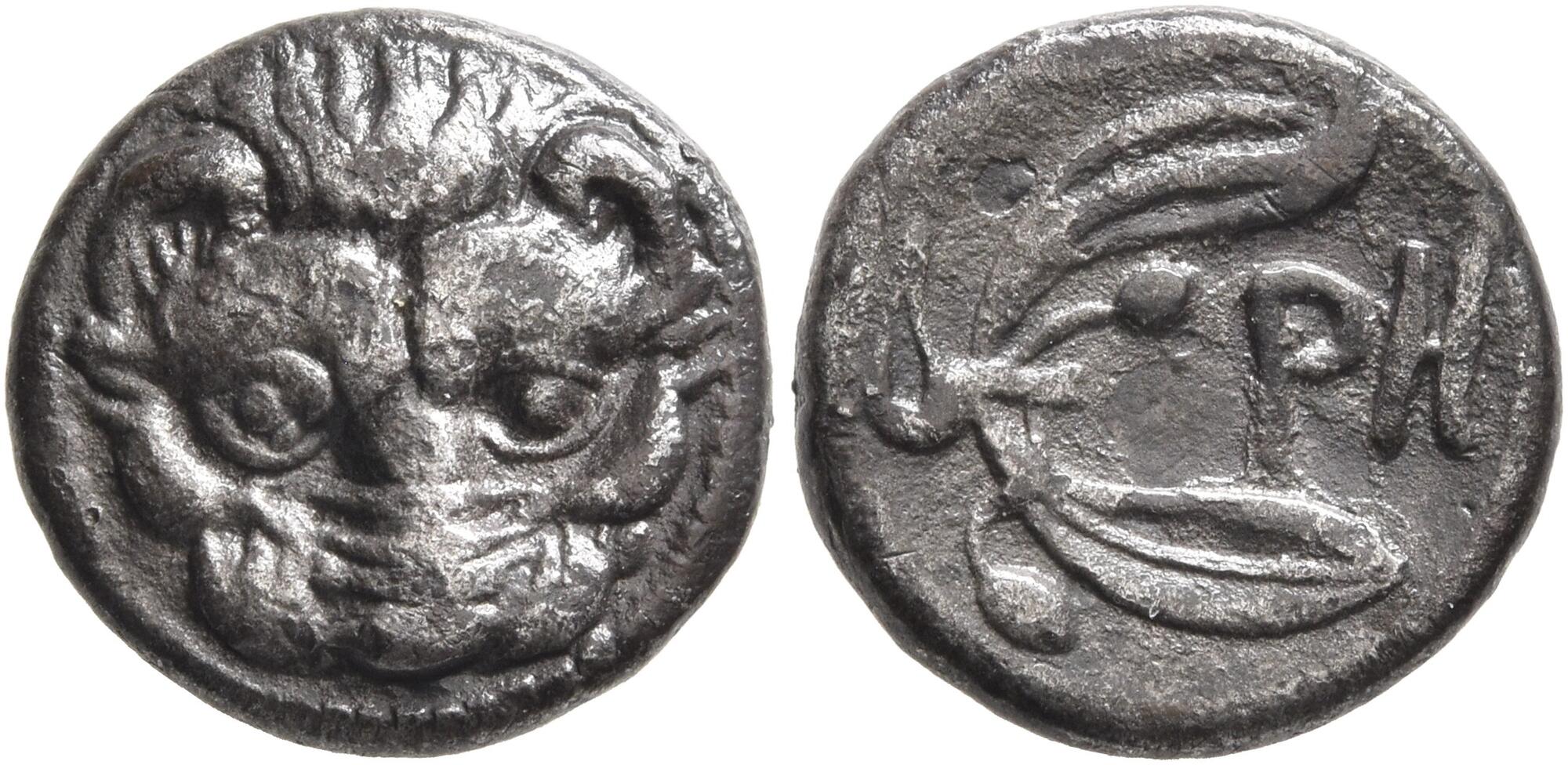Rhegium, silver, hemidrachms (420-387 BCE)
From SILVER
Revision as of 10:27, 11 November 2022 by Callatay (talk | contribs) (Callatay moved page AC 37a - Rhegium, silver, drachma, 356-351 BC to AC 37a - Rhegium, silver, hemidrachms (420-387 BCE))
420 BCE - 387 BCE Silver 556 kg
Description
| ObverseInscription or printing placed on the obverse.: | Facing head of a lion. |
| ReverseInscription or printing placed on the reverse.: | ΡΗ (Greek).ΡΗ Olive sprig. |
Mint and issuing power
| MintIdentifies the place of manufacture or issue of a numismatic object.: | Rhegium | Ancient regionAncient region.: | Modern countryModern country: Italy | AuthorityIdentifies the issuing power. The authority can be "pretended" when the name or the portrait of X is on the coin but he/she was not the issuing power. It can also be "uncertain" when there is no mention of X on the coin but he/she was the issuing power according to the historical sources: |
Chronology
| FromIdentifies the initial date in a range assigned in a numismatic context. | 420 BCE | toIdentifies the final date in a range assigned in a numismatic context.. | 387 BCE | PeriodTime period of the numismatic object.: Classical 480-323 BC |
Physical description
| MetalThe physical material (usually metal) from which an object is made.: | Silver |
Median weightMedian of the weights of numismatic objects (in grams). in grams | 2.05 | DenominationTerm indicating the value of a numismatic object. Examples: tetradrachm, chalkous, denarius.: | hemidrachm |
StandardStandard.: |
Image

AC 37a - Rhegium, silver, drachma, 356-351 BC.jpg [1]
References
| Die study referencePublication of the study: | Herzfelder 19571Herzfelder 1957, troisième série. | ||
| Coin series referenceReference to coin series study: | HN Italy2HN Italy, n° 249, HGC 13HGC 1, n° 1648 | ||
Obverse dies distribution
no distribution is available
Reverse dies distribution
no distribution is available
Quantification
| Number of obversesNumber of obverse dies. ᵖ (o) | Number of singletons (o1)The number of singleton coins. ᵖ | ||
| Number of reverse diesNumber of reverse dies. (r) | Number of coinsNumber of coins. (n) | 12 | |
| Coins per obverse dieNumber of coins per obverse die. (n/o) | Coins per reverse dieNumber of coins per reverse die. (n/r) | ||
| Reverse per obverse ratioRatio of obverse dies divided by reverse dies. (r/o) | Percentage of singletons (o1)number of coins (n) divided by the number of singletons (o1) ᵖ | % | |
| Original number of dies (O) (Carter 1983 formula)The estimation of the number of coins according to Carter 1983 ᵖ | Expression error: Missing operand for /. | Coins struck if 20,000 as average productivity per dieCoins made if the average productivity for obverses (according to Carter) is 20,000. ᵖ | |
| Original number of dies (O) (Esty 2011 formula)The estimation of the number of coins according to the singleton formula in Esty 2011 ᵖ (O) | Survival rate if 20,000 as average productivity per dieSurvival rate if average productivity is 20,000. ᵖ | 0.00004 | |
| Coverage (o = % of O) (Esty 1984 formula)Esty 1984 - coverage (% of O) ᵖ (o = % of O) | % | Die productivity if survival rate 1/2,000Average productivity if survival rate is 1/2,000. ᵖ | |
| Weight of silver (in kg) if 20,000 coins per die (O = Carter formula)Carter 1983 * Median weight * 20000 (*10 if gold or electrum) ᵖ | 556 kg | Die productivity if survival rate 1/5,000Average productivity if survival rate is 1/5,000. ᵖ |
Remarks
References
- ^ Herzfelder, Hubert (1957), Les monnaies d’argent de Rhégion frappées entre 461 et le milieu du IVe siècle av. J.-C., Paris, 1957, 154 p., 20 pl.
- ^ Rutter N. Keith et alii (eds.) (2001), Historia Numorum Italy, London, xvi, 223 p., 43 pl.
- ^ Hoover, Oliver D. (2018), The Handbook of Greek Coinage Series, Volume 1. Handbook of Coins of Italy and Magna Graecia, Sixth to First Centuries BC., Lancaster-London, 2018, lxi, 527 pages, 23 cm